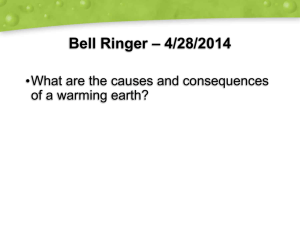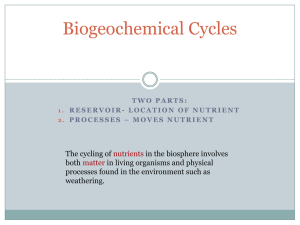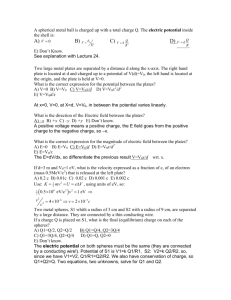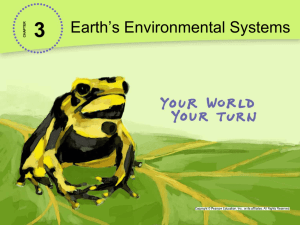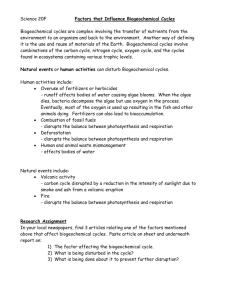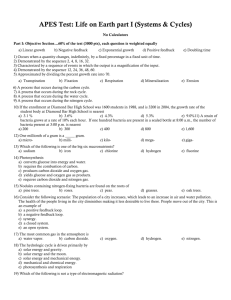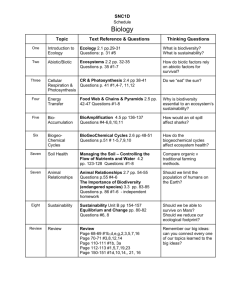ch 3 powerpoint
advertisement
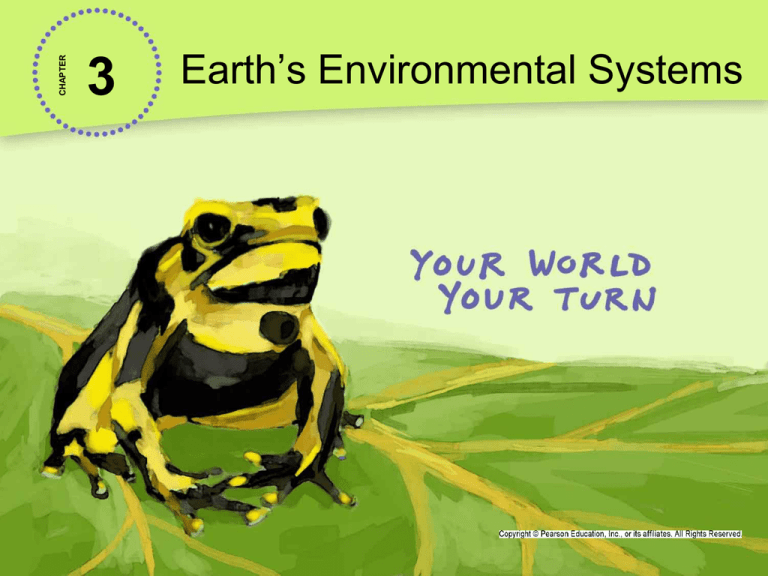
CHAPTER 3 Earth’s Environmental Systems The Gulf of Mexico’s Dead Zone • Nutrient-rich runoff causes plankton blooms and hypoxia—low oxygen levels—in the Gulf of Mexico. • Hypoxia kills or displaces marine organisms, causing a decline in the fisheries and the fishing industry. • U.S. government and farmers debate the need to cut down on fertilizer use. Talk About It Do you think the distance between the source of the nitrogen and phosphorus and the dead zones themselves makes it difficult to manage this problem? Why or why not? Lesson 3.1 Matter and the Environment Water’s abundance is a primary reason there is life on Earth. Lesson 3.1 Matter and the Environment Atoms and Elements • Atoms are the basic unit of matter. • Nucleus: Contains protons and neutrons • Electrons: Move around the nucleus • An element is a substance that cannot be broken down into other substances. Did You Know? There are 92 elements that occur naturally, and scientists have created about 20 others in labs. What are the basic units of matter? A. Elements B. Atoms C. Electrons D. Neutrons E. Protons s 0% Pr ot on ns 0% Ne ut ro s 0% ro n At o m s 0% Ele ct El em en ts 0% Lesson 3.1 Matter and the Environment Bonding • Atoms combine by bonding: • Covalent bonds: Electrons are shared. • Ionic bonds: Electrons are transferred. • Molecule: Two or more atoms joined by covalent bonds • Compound: Substance composed of atoms of two or more different elements Covalent bonding Ionic bonding When electrons are transferred what type of bond is it? A. Covalent B. Ionic C. Molecule D. Compound E. Atomic ic 0% At om Co m ol ec ul Io ni c 0% po un d 0% e 0% M Co v ale nt 0% Lesson 3.1 Matter and the Environment Organic and Inorganic Compounds • Organic compounds: Consist of covalently bonded carbon atoms and often include other elements, especially hydrogen • Hydrocarbons: Organic compounds, such as petroleum and wood smoke, that contain only hydrogen and carbon • Inorganic compounds: Lack carbon-to-carbon bonds Organic compounds include natural gas, petroleum, coal, and gasoline. Which of the following is NOT an organic compound A. Petroleum B. Natural gas C. Coal D. Gasoline E. Ammonia 0% Am m on i in a e 0% Ga so l l 0% Co a ra l ga s 0% Na tu Pe tro le um 0% Lesson 3.1 Matter and the Environment Solutions • A mixture is a combination of elements, molecules, or compounds that are not bonded chemically. • Solutions are mixtures in which all ingredients are equally distributed. • Mixtures can be solids, liquids, or gases. Blood, sea water, plant sap, and metal alloys, such as brass, are all solutions. Lesson 3.1 Matter and the Environment Macromolecules • Large organic compounds that are essential to life • Proteins: Serve many functions in organisms; include C, H, O, N, S; may help with production of tissues, store energy, act as hormones, or serve as enzymes • Nucleic Acids: Direct protein production; include DNA (carries hereditary info and is responsible for passing on traits) and RNA (copies DNA to make protein) • Carbohydrates: Provide energy and structure; include sugars, starch, and cellulose (C, H, O) • Lipids: Not soluble in water; many functions; include fats, waxes, and hormones; not a polymer Which of the following is NOT a macromolecule A. Proteins B. Nucleic Acid C. Carbohydrates D. Atoms E. Lipids s 0% L ip id s 0% At om at es 0% bo hy dr Ca r Ac id 0% Nu c le ic Pr ot ei n s 0% Lesson 3.1 Matter and the Environment Water • Water is required by all living things for survival. • Polar molecule: shared electrons are not evenly distributed • Oxygen end is more negative • Hydrogen bond: an oxygen atom of a water molecule is weakly attracted to one or two hydrogen atoms of another Lesson 3.1 Matter and the Environment Water • Hydrogen bonding gives water many unique properties: • Cohesion • Water sticks to itself • Allows the transport of materials, like nutrients and waste, in plants and animals • Resistance to temperature change • Water can absorb a large amount of energy with only small changes in its temperature • Helps stabilize aquatic ecosystems and climates in which they exist • Ice density • Water molecules in ice are farther apart than in liquid water • Less dense when frozen • Universal solvent: Ability to dissolve many other molecules Which property of water allows it to stick to itself? Bu oy a e tu r te m pe ra to ce Re sis ta n 0% nc y 0% n 0% es io en t 0% ol v lS ve rs a Un i Ice de ns it y 0% Co h A. Ice density B. Universal Solvent C. Cohesion D. Resistance to temperature E. Buoyancy Lesson 3.1 Matter and the Environment Acids, Bases, and pH • The separation of water molecules into ions causes solutions to be acidic, basic, or neutral. • The pH scale measures how acidic or basic a solution is. • pH of 7—Neutral: Equal concentrations of H+ and OH- • pH below 7—Acidic: Relatively high concentration of H+ • pH above 7—Basic: Relatively high concentration of OH- Lesson 3.2 Systems in Environmental Science Positive feedback loops can help erosion turn a fertile field to desert in just a few years. Dust storm, Stratford Texas, 1930s Lesson 3.2 Systems in Environmental Science Interacting Systems • Inputs into Earth’s interconnected systems include energy, information, and matter. • Feedback loops - regulate systems – circular process that describes how an event is both a cause and an effect in the same system Negative feedback loop • Negative feedback loops: Result in stabilization of a system • Positive feedback loops: Result in a system moving to an extreme Did You Know? Predator-prey cycles are negative feedback loops. If prey populations rise, predator populations can rise in response, causing prey populations to fall. Then predator populations may decline, allowing prey populations to rise again, and so on. Which of following results in the stabilization of a system? A. Positive feedback loop B. Feedback Loop C. Neutral Feedback Loop D. Negative Feedback Loop E. Feedback system 0% 0% 0% 0% Lo lF op ee db Ne ac ga kL t iv oo e Fe p ed ba ck Lo Fe op ed ba ck sy st em ac k Fe ed b Ne ut ra Po sit iv ef ee db ac k lo op 0% Identify and explain if it is a negative or positive feedback loop • You get a rash from poison ivy. You know you shouldn't scratch it, but it itches. So you scratch. But scratching makes it itch more, and can even make the rash spread to areas that didn't itch before. The more you scratch, the more it itches. Identify and explain if it is a negative or positive feedback loop • The thermostat attached to an air conditioner helps maintain a constant temperature in your house. During the summer, the sun heats the house and the temperature goes up. When the temperature goes up, the thermostat turns on the air conditioner, causing the house to cool down. When the house is cool again, the thermostat turns the air conditioner off. Identify and explain if it is a negative or positive feedback loop • In the picture below, blood pressure has increased. Receptors in the carotid arteries detect the change in blood pressure and send a message to the brain. The brain will cause the heart to beat slower and thus decrease the blood pressure. Identify and explain if it is a negative or positive feedback loop My mom had a blood clot at the age of 40. Once a vessel is damaged, platelets start to cling to the injured site and release chemicals that attract more platelets. The platelets continue to pile up and release chemicals until a clot is formed. Identify and explain if it is a negative or positive feedback loop • Regulation of blood sugar in humans - When blood sugar rises, insulin sends a signal to the liver, muscles and other cells to store the excess glucose. Some is stored as body fat and other is stored as glycogen in the liver and muscles. Identify and explain if it is a negative or positive feedback loop • Carbon dioxide is considered a "greenhouse gas" since it absorbs heat that would otherwise dissipate out into space. If there is more carbon dioxide in the atmosphere, global temperatures are likely to increase. It is possible that plants will respond to the increased carbon dioxide and increased temperatures with an increase in photosynthesis. Since carbon dioxide is needed for photosynthesis, this could reduce the amount of carbon dioxide in the atmosphere, leading to cooler temperatures. Is this a positive or negative feedback loop? Identify and explain if it is a negative or positive feedback loop • Here are some examples related to ecosystems and global climate change. Ice caps at the north and south poles are very reflective -- the ice reflects light and heat rather than absorbing it. If global warming occurs, then the increase in temperature will cause polar ice to melt, and the bare dark ground will absorb rather than reflect heat. This additional absorption of heat will further boost the temperature of the earth. Is this a positive or negative feedback loop? Lesson 3.2 Systems in Environmental Science Spheres of Function • Earth can be divided into spheres that are defined according to their location and function. Lesson 3.3 Earth’s Spheres The movement of Earth’s plates has formed the deepest ocean trenches and the highest mountains. Lesson 3.3 Earth’s Spheres The Geosphere • Rocks and minerals on and below Earth’s surface: • Crust: Thin, cool, rocky outer “skin” • Mantle: Very hot and mostly solid • Core: Outer core is molten metal, inner core is solid metal Rock formation, Ouray National Wildlife Refuge, Utah Lesson 3.3 Earth’s Spheres Plate Tectonics • Crust and mantle are divided into: • Lithosphere: Crust and uppermost mantle; divided into tectonic plates • Asthenosphere: Soft middle mantle; heated by outer core • Lower mantle: Solid rock • Convection currents in the asthenosphere move tectonic plates. • Collisions and separations of the plates result in landforms. Volcano lava Lesson 3.3 Earth’s Spheres Tectonic Plates • There are three major types of plate boundary: • Divergent • Transform • Convergent Lesson 3.3 Earth’s Spheres Divergent and Transform Plate Boundaries • Divergent boundaries: Rising magma pushes plates apart. Divergent plate boundary • Transform boundaries: Plates slip and grind alongside one another. Transform plate boundary Lesson 3.3 Earth’s Spheres Convergent Plate Boundaries • Plates collide, causing one of two things to happen: • Subduction: One plate slides beneath another. • Mountain-building: Both plates are uplifted. Lesson 3.3 Earth’s Spheres The Biosphere and Atmosphere • Biosphere: The part of Earth in which living and nonliving things interact • Atmosphere: Contains the gases that organisms need, such as oxygen; keeps Earth warm enough to support life Earth’s atmosphere, seen from space Lesson 3.3 Earth’s Spheres The Hydrosphere • Consists of Earth’s water Greenlaw Brook, Limestone, Maine • Most of Earth’s water (97.5%) is salt water. • Only 0.5% of Earth’s water is unfrozen fresh water usable for drinking or irrigation. • Earth’s available fresh water includes surface water and ground water. Did You Know? If it is depleted, groundwater can take hundreds or even thousands of years to recharge completely. Lesson 3.3 Earth’s Spheres The Water Cycle Which of the following spheres contains rocks and minerals below earth’s surface? 59% A. Biosphere B. Crust C. Lithosphere D. Atmosphere E. Geosphere 18% 18% 6% Ge os ph er e os ph er e At m st Cr u L it ho sp he re Bi os ph er e 0% What type of boundary occurs when rising magma pushes plates apart 88% M 6% Su bd uc tio g n 0% ld in ou nt ai n- ve rg en t 0% Co n er ge nt Di v Tr an sf or m 6% bu i A. Transform B. Divergent C. Convergent D. Mountain-building E. Subduction What type of boundary occurs when plates collide? 88% A. Divergent B. Transform C. Convergent D. Subduction E. Mountain-Building 12% in g Bu ild n- tio n 0% M ou nt ai Su bd uc ve rg en t 0% Co n an sf or m Tr Di v er ge nt 0% The part of Earth in which living and non living things interact occurs in which sphere? 88% 6% Ge os ph er e 0% L it ho sp he re os ph er e Bi Hy dr o sp he re 0% 6% At m os ph er e A. Hydrosphere B. Biosphere C. Atmosphere D. Lithosphere E. Geosphere Lesson 3.4 Biogeochemical Cycles A carbon atom in your body today may have been part of a blade of grass last year, or a dinosaur bone millions of years ago. Fossilized bones in a Colorado dig. Lesson 3.4 Biogeochemical Cycles Nutrient Cycling • Matter cycles through the environment. • Matter can be transformed, but cannot be created or destroyed – Law of Conservation of Matter • Nutrients, matter that organisms require for life process, circulate throughout the environment in biogeochemical cycles. Did You Know? Organisms require several dozen nutrients, such as nitrogen, phosphorus, and carbon, to survive. Lesson 3.4 Biogeochemical Cycles Nutrient Cycling • Biogeochemical cycles – nutrients cycle endlessly throughout the environment in complex cycles • Carbon • Phosphorus • Nitrogen • The water cycle also plays a part in all biogeochemical cycles Did You Know? Organisms require several dozen nutrients, such as nitrogen, phosphorus, and carbon, to survive. Lesson 3.4 Biogeochemical Cycles The Carbon Cycle Lesson 3.4 Biogeochemical Cycles The Phosphorus Cycle Lesson 3.4 Biogeochemical Cycles The Nitrogen Cycle Which of following is NOT a macronutrient A. Carbon B. Phosphorus C. Hydrogen D. Nitrogen tro ge n 0% Ni ge n 0% Hy dr o us 0% Ph os ph or Ca r bo n 0% Which cycle relies on bacteria? A. Phosphorus B. Carbon C. Nitrogen D. Cell Respiration E. Photosynthesis 0% ra tio n Ph ot os yn th es is 0% es pi Ce ll R tro ge n 0% Ni bo n 0% Ca r Ph os ph or us 0%
